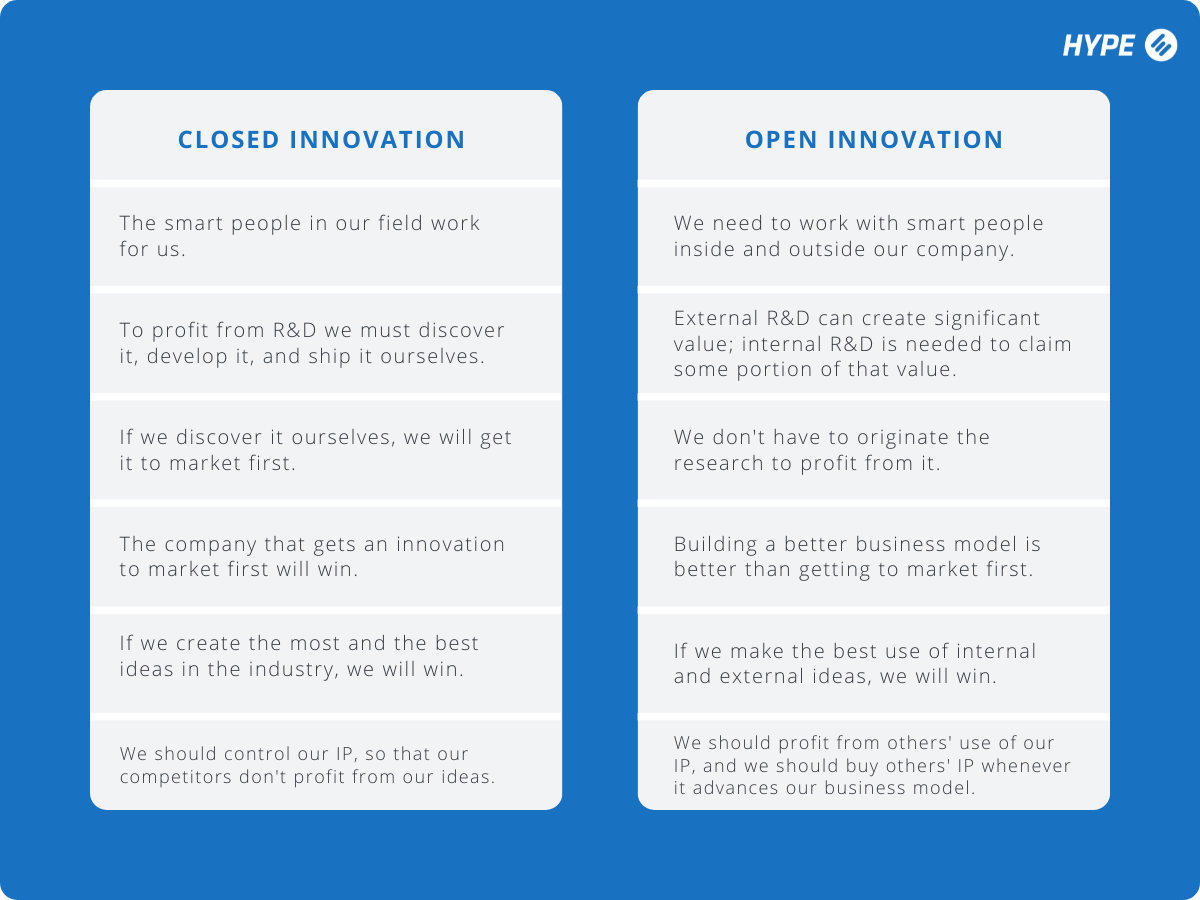Open Innovation: Nearly everything you need to know
Learn about the concept of open innovation and why it's so important to the growth of your business
To help you maximize the benefits of open innovation, we’ve created this guide, packed with actionable tactics, inspiration and best practices for tailoring your own open innovation process to your business.
Subscribe to the HYPE Innovation Blog
In today’s world, when staying relevant in the market is no longer enough to remain competitive, we, as businesses, need to start thinking ahead and walk the extra mile in order to become the change-makers who outperform the competition.
Continuous improvement is great, and it helps us to constantly improve little by little. However, if we want to outperform the competition and truly delight our customers, we need to start looking for ideas, technologies, and new ways of doing business outside of our own organization’s walls.
The most successful companies around the globe are implementing open innovation strategies because finding opportunities and innovations outside their organizations boosts their business growth exponentially, enables them to stay ahead of the competition and ensures that their customers and employees are engaged and loyal to the company.
Yet many innovation managers and leaders struggle with building scalable and effective open innovation processes that bring the results they expect.
Why?
Because open innovation is a new and complex concept. It involves many different stakeholders within an organization as well as third parties outside of it, and necessitates building brand new strategies and processes from the ground up.
But first things first, let’s review what open innovation means.
What does open innovation mean?
"Open innovation" refers to an innovation approach where organizations absorb external ideas into their own business, new technologies, trends, business models, or new approaches to launching a new product or service, and by doing so, are able to grow their market share, improve their competitiveness, and improve their processes.
The most common open innovation sources are:
- Customers, consumers, users, and fans
- Suppliers
- Research institutes
- Universities and students
- Startups
- Technical consultants
- Partner companies from adjacent markets
- Inventors
Open innovation according to Henry Chesbrough
Widely acknowledged as the "father of open innovation," UC Berkeley Professor Henry Chesbrough originally introduced the term in 2003. Now, open innovation has also come to describe a company's ability to institute a cultural change, specifically its attitude toward interfirm collaboration.

In his groundbreaking book, “Open Innovation: The New Imperative for Creating and Profiting from Technology”, Henry Chesbrough argued that in the face of changing market circumstances such as globalization, digitization, shorter product life cycles, or complex social and economic challenges, large companies could no longer afford to rely solely on their internal ideas and capabilities. Instead of pursuing innovation on their own, Chesbrough advises companies to leverage external sources of ideas. Chesbrough argued that by embracing external inputs, companies would be in a much better position to advance their business.
Open innovation vs closed innovation
Open innovation's philosophy is based on the idea that companies may not employ all the bright minds in the world, but they can still work with them. Using open innovation, companies can tap into the collective knowledge and expertise of their key audiences and stakeholders.

In the closed innovation world, there is a strong belief that companies should control the creation and management of ideas and, therefore, intellectual property. Companies engaging in closed innovation tend to believe that the smart people in the industry all work for them. They think that only by isolating ideas and inventions from the competitive outside world will they win the race. This paradigm of inward orientation is often referred to as the "Not-invented-here syndrome."
The open innovation approach is just the opposite. Not only can you collaborate internally and externally, but open innovation can also be implemented through various approaches, depending on the direction of knowledge flows. Additionally, open innovation builds on the belief that knowledge sources for innovation exist both inside and outside the boundaries of a company.
While supporters of closed innovation typically see collaboration with external parties as cumbersome, unmanageable, and potentially dangerous (especially IP-wise), open innovation practitioners believe the exact opposite, i.e., all knowledge outside an organization's boundaries can be specified and managed, and collaboration in general brings value to a company.
Why is open innovation important?
Open innovation challenges the status quo by disrupting the traditional view on how a business should operate. Instead of using only our own internal employees, resources, and knowledge, open innovation expands the opportunity set for innovation by allowing us to create value using resources and solutions that are sitting outside of our organization. As a result, open innovation offers tremendous potential for more growth and value while also helping to tame the costs associated with innovation.
Especially in the face of changing market trends, even well-established organizations recognize the limitations of their innovation capabilities. To stay relevant and profitable, every organization should consider the compelling benefits of open innovation.
Open innovation provides:
- Access to creative and innovative ideas outside of our organization
- Access to experts and specialists not employed by our organization
- Access to customers and fans and their insights and feedback
- Possibilities to create new products and services
- Faster development times and time to market
- Lower development risk and costs
- Better employee engagement
- Improved brand image
- Competitive advantages
Creating Value for the Customer through Innovation
An in-depth case study exploring the Fujitsu Activ8 program for customer co-creation.
What are the different approaches to open innovation?
Open innovation is an exercise in knowledge exchange, transfer, and management. Knowledge can either flow toward an organization (outside-in), away from it (inside-out), or in both directions (coupled).
Outside-in open innovation
The outside-in approach – undoubtedly the most popular approach among successful global players – has two main focuses: the acquisition of ideas and the integration of partners into the development and implementation process.
To let knowledge flow into an organization, companies can:
- Engage in technology scouting;
- In-license IP – To produce the Lord of the Rings, Peter Jackson had to get a license from the Saul Zaentz Company, which holds the movie rights to J. R. R. Tolkien's work;
- Set up joint university research programs – see Merck with UC San Diego in the fight against neglected tropical diseases;
- Fund startup companies in their industry or in adjacent industries – see VIA by Veolia;
- Collaborate with intermediaries, suppliers, and customers to improve their open innovation practices – see Siemens.
Inside-out open innovation
In the inside-out approach, internal knowledge is exploited externally. To let knowledge flow out, companies can:
- Out-license (or even cross-license) some of their IP and technology – see Google and Samsung;
- Donate IP – see Tesla's "All our patents belong to you" announcement and Toyota's opening up of hydrogen patents;
- Create spin-offs and spin-outs – see Apple's General Magic and Apperian;
- Set up corporate venture capital funds – see LEO Ventures by LEO Pharma;
- Support or set up incubators and accelerators – see Orbia's accelerator.
Coupled open innovation
Finally, in coupled process mode, companies can simultaneously let knowledge flow in and out of their boundaries by creating:
- Strategic alliances – see Unilever and Ocean Nutrition for Becel Margarine;
- Consortia and networks – see EIT Food or Reimagining Fundraising;
- Ecosystems – see Salesforces' Business Partner Ecosystem or Paint The Future.C
How to effectively manage open innovation
To leverage external innovation sources, organizations must set up appropriate structures and mechanisms like:
- independent open innovation teams
- spaces for innovation and interaction
- digital tools and platforms
- staff rotation
- appropriate training
Open innovation promotes change as a source of value for an organization because, for effective open innovation, organizations must nurture a culture that accepts new ideas, encourages experimentation, promotes trust and sharing, and supports continuous learning and adaptation.
Follow the steps below, tailored to your company’s individual requirements, and you'll have a solid foundation for your innovation management:
- Define your objectives. Start out by defining your objectives and setting your innovation goals.
- Choose the best approach. Decide on an open innovation approach most aligned with your business strategy and the open innovation goals you set at step 1.
- Start small. Run an internal campaign to pilot your approach with a safe audience and fine-tune your messaging.
- Identify your target audience. Which third party offers the perspective and expertise you’re looking for?
- Use a trustworthy platform. Use the right open innovation management software to facilitate your open innovation program, enable your engaged employees and other stakeholders to drive the discussion, and keep other participants motivated.
- Communicate. As with any innovation initiative, communication is everything. Ensure you constantly provide feedback about individual ideas and what's happening in your campaign. Emphasize the behaviors you’re looking for and give examples of the best ways to participate.
How to measure open innovation
To design and implement a successful metrics-based open innovation performance measurement system, companies should adhere to three principles:
- Use unique metrics for each open innovation method.
- Consider different types of measures: Use a variety of KPIs that assess the input, process, output, and outcome.
- Think about how to utilize open innovation metrics effectively: Distinguish between those for instrumental use (direct decision-making), conceptual use (general enlightenment and understanding), and symbolic use (to justify decisions after they’ve been taken).
Open innovation tools and platforms
The term open innovation platform usually refers to either, very generally, a system of stakeholders and rules to conduct open innovation or, more specifically, a software platform with dedicated functionality to conduct open innovation. It all depends on individual use cases. Here are some examples:
Open innovation software
Managing a complex process with so many stakeholders involved, the right open innovation software is essential to help you automate and streamline your processes, keep everyone up to date, and achieve the best results.

There are various software providers in the market, including HYPE Innovation. Our open innovation module, which is just one of the innovation ecosystem building blocks we offer our clients, can serve as a central hub for all your innovation needs and is customizable for any type of company and use case.
Living labs
Living labs are open innovation networks where users, consumers, and households are systematically involved in the emerging, iterative development of new solutions. They can be companies, NGOs, governmental offices, universities, or citizens, collaborating for the creation, prototyping, and validation of new solutions, products, and services.
The key idea is to use open scenarios to test software and services outside closed-lab environments.
Innovation consultancies
Innovation consultancies usually offer the full spectrum of innovation services for your innovation program, from goal setting to strategic planning and implementation. You may already have a problem or a goal in mind but the necessary resources might not always be available in-house. That’s when innovation consultancies can play an important role as an extension of your team for a project or a period of time.
At HYPE Innovation, our team of ex-innovation managers and innovation consultants are always ready to offer their full support for your innovation program, from strategic planning to hands-on implementation and execution.
Looking for an Open Innovation Software?
With HYPE you can tap into the full power of external collaboration.

We make software that helps companies connect people with ideas, to drive innovation and transformation forward.

The HYPE Newsletter - Send me updates
Please keep me posted on Hype’s latest new product features and innovation management insights.


